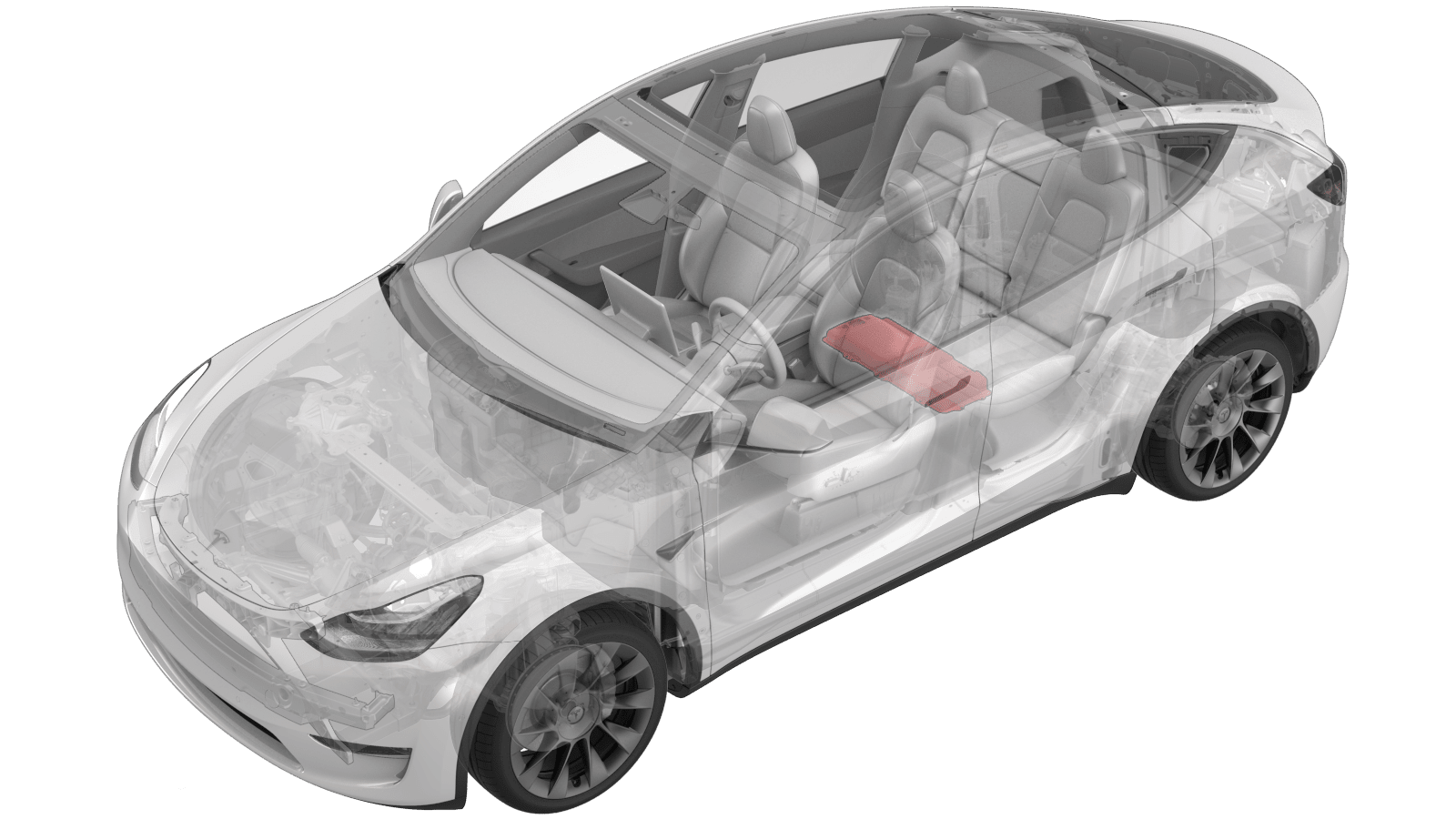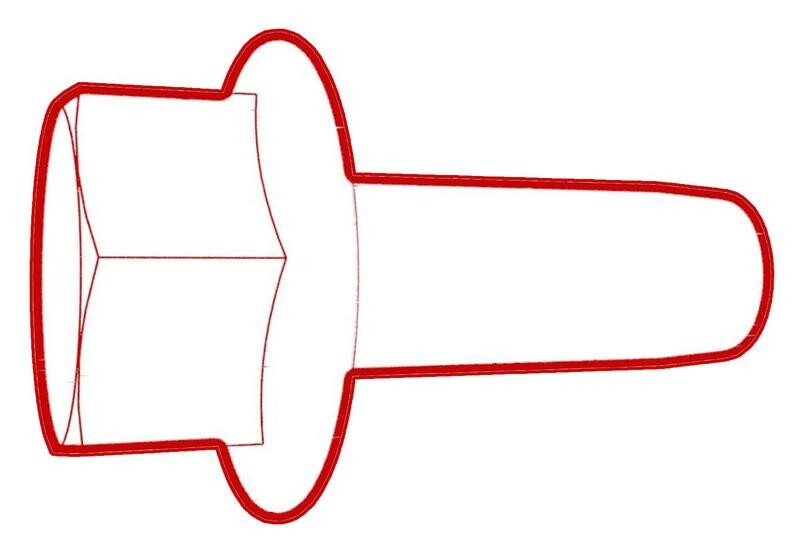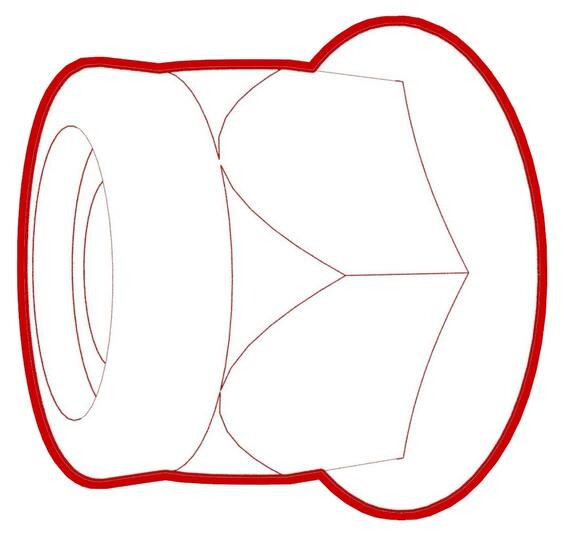Système de conversion d’énergie (Ensemble non-structurel)(retrait et installation)
 Code de correction
16301001 2.34
REMARQUE : À moins d’indications explicites contraires dans la procédure, le code de correction et le temps forfaitaire ci-dessus représentent tout le travail à être fait pour cette procédure, notamment les procédures connexes. N’appliquez pas plusieurs codes de correction à la fois, à moins qu’il vous soit explicitement indiqué de le faire.
REMARQUE : Consultez Temps forfaitaires pour en apprendre plus à propos des temps forfaitaires et de leur création. Vous pouvez transmettre par courriel vos commentaires relatifs aux valeurs des temps forfaitaires à l'adresse ServiceManualFeedback@tesla.com.
REMARQUE : Consultez Protection individuelle pour vous assurer de porter l’équipement de protection individuelle adéquat lors vous effectuez la procédure ci-dessous. Voir Précautions ergonomiques pour consulter les pratiques de travail sécuritaires et saines.
Code de correction
16301001 2.34
REMARQUE : À moins d’indications explicites contraires dans la procédure, le code de correction et le temps forfaitaire ci-dessus représentent tout le travail à être fait pour cette procédure, notamment les procédures connexes. N’appliquez pas plusieurs codes de correction à la fois, à moins qu’il vous soit explicitement indiqué de le faire.
REMARQUE : Consultez Temps forfaitaires pour en apprendre plus à propos des temps forfaitaires et de leur création. Vous pouvez transmettre par courriel vos commentaires relatifs aux valeurs des temps forfaitaires à l'adresse ServiceManualFeedback@tesla.com.
REMARQUE : Consultez Protection individuelle pour vous assurer de porter l’équipement de protection individuelle adéquat lors vous effectuez la procédure ci-dessous. Voir Précautions ergonomiques pour consulter les pratiques de travail sécuritaires et saines.
- 1111868-00-B Retrait connecteur, liquide de refroidissement, PCS, M3
- 1135762-00-A Trousse, prise Svc, flexible liquide refroidissement, Model 3
- 1114917-00-A Outil, ventouse, 3 po x 6 po (quantité 2)
- 1076927-00-A Résistivohmmètre, micro ohm, Hioki RM 3548
Seuls les techniciens qui ont complété tous les cours de la certification requis sont autorisés à effectuer cette procédure. Tesla recommande aux techniciens fournisseurs de service tiers de suivre la formation équivalente avant d'exécuter cette procédure. Pour obtenir plus d'information sur les exigences pour les techniciens Tesla ou les descriptions à ce sujet pour les tiers, consultez les exigences pour la certification HT. Portez toujours un équipement de protection personnelle et des gants isolants haute tension ayant un classement minimal de 0 (1000 volts) avant de manipuler un câble, une barre omnibus ou des raccords haute tension. Se référer à Tech Note TN-15-92-003, Mises en garde relatives à la haute tension
pour des informations supplémentaires sur la sécurité.
Spécifications de couple
| Description | Valeur de couple | Outils recommandés | Réutiliser/remplacer | Remarques |
|---|---|---|---|---|
| Boulons qui fixent le système de conversion d’alimentation à la batterie haute tension |
 18 Nm (13.3 lbs-ft) |
|
Réutiliser | À l’installation, marquez chaque boulon avec un stylo de peinture |
Retirer
-
Placez le véhicule sur le pont élévateur à 2 colonnes.
TIpAssurez-vous que le véhicule n’est pas en cours de recharge.
- Ouvrez les portes et abaissez les fenêtres.
- Retirez le dossier du siège de droite de la deuxième rangée. Voir Dossier de siège - 2e rangée - droit (retirez et remplacez),
- Retirez le dossier du siège de gauche de la deuxième rangée. Voir Dossier de siège - 2e rangée - gauche (retirez et remplacez),
- Effectuez la procédure de désactivation HT du véhicule. Voir Procédure de désactivation HT du véhicule,
- Retirer le couvercle de la baie auxiliaire. Voir Couvercle - baie auxiliaire (retirer et remplacer),
-
Inspectez la baie auxiliaire pour déceler tout isolateur manquant. Installez les isolateurs manquants avant de continuer.
RemarqueLe nombre de boulons sur les véhicules récents peut varier.
-
Réinstallez le capuchon du connecteur logique sur le connecteur du contrôleur haute tension (CHT).
-
Soulevez le contrôleur haute tension verticalement, puis maintenez le contrôleur avec un tendeur élastique.
- Retirez les gants isolants HT.
- Vidangez le liquide de refroidissement du système de conversion de puissance. Voir Liquide de refroidissement des baies auxiliaires (vidange et remplissage),
- Abaissez complètement le véhicule.
- Inspectez les gants isolants HT, puis enfilez les gants isolants HT ainsi que les surgants en cuir.
- Retirez le sectionneur de batterie pyro. Voir Sectionneur de batterie pyrotechnique (retirez et remplacez),
- Positionnez des serviettes absorbantes sous et autour des tuyaux d'entrée et de sortie du liquide de refroidissement du système de conversion de puissance (PCS) pour éviter les gouttes excessives de liquide de refroidissement.
-
Utilisez l'outil de retrait du connecteur de liquide de refroidissement pour libérer les attaches qui fixent le tube d'entrée de liquide de refroidissement au système de conversion de puissance et retirez le tube du système de conversion de puissance. Voir Tuyau - entrée - liquide de refroidissement - système de conversion d’énergie (retirez et remplacez),
RemarqueCette vidéo montre comment débrancher le tuyau du liquide de refroidissement du système de conversion de puissance et brancher les raccords.
- Installez les bouchons dans l'orifice d'entrée de liquide de refroidissement du système de conversion de puissance et l'extrémité ouverte du tube d'entrée de liquide de refroidissement.
-
Utilisez l'outil de retrait du connecteur de liquide de refroidissement pour libérer les attaches qui fixent le tube de sortie du liquide de refroidissement au système de conversion de puissance, et retirez le tube du système de conversion de puissance. Voir Tube - sortie - liquide de refroidissement - système de conversion d’énergie (retirez et remplacez),
RemarqueReportez-vous à la vidéo dans l'étape précédente.
- Installez les bouchons dans l'orifice de sortie du liquide de refroidissement du système de conversion de puissance et dans l'extrémité ouverte du tube de sortie du liquide de refroidissement.
-
Essuyez les orifices de refroidissement du système de conversion de puissance, essuyez les extrémités des tubes de liquide de refroidissement et essuyez tout liquide de refroidissement renversé.
ATTENTIONLe liquide de refroidissement renversé peut créer un chemin électrique.
-
Débranchez le connecteur BT du système de conversion de puissance.
TIpUtilisez un outil de finition en plastique pour soulever la languette de verrouillage vers le haut.
-
Débranchez le connecteur BT, le connecteur HT du bus CC et le connecteur du faisceau d'entrée CA de la batterie HT du système de conversion de puissance.
-
Retirez les boulons à tête hexagonale qui fixent le système de conversion de puissance à la batterie HT.
ATTENTIONRetirez uniquement les boulons hexagonaux de 8 mm. NE retirez PAS les boulons Torx T30.RemarqueCertains supports de système de conversion de puissance à 5 boulons n'ont que 4 boulons. Lors de l'installation du système de conversion de puissance, installez le cinquième boulon.TIpL'un ou plusieurs des outils suivants sont recommandés :
- Outils isolés :
- Douille de 8 mm
- Rallonge de 10 po
- Clé à cliquet/Clé dynamométrique
- Outils isolés :
-
Installez 2 ventouses sur le système de conversion de puissance.
ATTENTIONN'installez pas les ventouses sur des étiquettes, car cela réduirait l'aspiration.RemarqueContinuez à appuyer sur le bouton d'aspiration jusqu'à ce que l'indicateur de ligne rouge ne soit plus visible.
-
Avec de l'aide, utilisez des ventouses pour soulever le système de conversion de puissance hors du compartiment auxiliaire.
RemarqueLors du retrait du PCS du véhicule, un technicien doit être dans le véhicule, soulever le PCS de la baie auxiliaire et le donner au technicien adjoint qui se tient à l'extérieur du véhicule.ATTENTIONMaintenez le niveau du système de conversion de puissance lorsque vous le soulevez pour éviter de renverser du liquide de refroidissement.
- Inspectez la zone pour les résidus de liquide de refroidissement et essuyez avec une serviette propre.
- Retirez les bouchons du système de conversion de puissance, vidangez le liquide de refroidissement dans un drain de liquide de refroidissement, puis replacez les bouchons.
- Retirez les tampons absorbants autour des orifices de liquide de refroidissement du système de conversion de puissance.
- Retirez les ventouses du système de conversion de puissance.
Installer
- Effectuez un réglage à zéro du compteur de résistance Hioki en préparation pour une mesure des résistances, plus tard dans cette procédure. Voir Compteur de résistance (réglage zéro),
- Essuyez le système de conversion de puissance à sec.
-
Inspectez la zone de la baie auxiliaire où le système de conversion de puissance sera installé et essuyez tout liquide de refroidissement renversé.
ATTENTIONLe liquide de refroidissement renversé peut créer un chemin électrique.
- Assurez-vous que tous les isolateurs de barre omnibus sous le PCS sont présents.
-
Avec de l'aide, utilisez les ventouses pour soulever le système de conversion de puissance dans la baie auxiliaire, avec les références alignés sur les trous PC, puis retirez les ventouses.
RemarqueLors de l'installation du PCS dans la baie auxiliaire, le technicien adjoint doit se tenir à l'extérieur du véhicule et remettre le PCS au technicien qui se trouve à l'intérieur du véhicule.
-
Installez les boulons à tête hexagonale qui fixent le système de conversion de puissance à la batterie HT, puis marquez les boulons avec un stylo à peinture après les avoir serrés au couple.
 18 Nm (13.3 lbs-ft)RemarqueSi le montage du système de conversion de puissance à 5 boulons n'avait que 4 boulons, installez le cinquième boulon.TIpL'un ou plusieurs des outils suivants sont recommandés :
18 Nm (13.3 lbs-ft)RemarqueSi le montage du système de conversion de puissance à 5 boulons n'avait que 4 boulons, installez le cinquième boulon.TIpL'un ou plusieurs des outils suivants sont recommandés :- Outils isolés :
- Douille de 8 mm
- Rallonge de 10 po
- Clé à cliquet/Clé dynamométrique
- Outils isolés :
-
Branchez le connecteur logique, le connecteur HT du bus CC et le connecteur du faisceau d'entrée CA de la batterie HT au système de conversion de puissance.
RemarqueAssurez-vous que les connecteurs sont bien en place, puis engagez les languettes de verrouillage.TIpPour verrouiller les connecteurs d'entrée AC du bus CC HT et de la batterie HT, appuyez sur la languette de verrouillage.
-
Branchez le connecteur BT au système de conversion de puissance.
TIpAssurez-vous que le connecteur est bien en place, puis appuyez sur la languette de verrouillage.
- Coupez une fente à mi-chemin à travers 2 tampons absorbants et entourez chaque raccord de tube de liquide de refroidissement du système de conversion de puissance avec un tampon.
- Retirez les bouchons du tube de sortie du liquide de refroidissement et du raccord de sortie du liquide de refroidissement.
- Remplacez les joints toriques du tube de sortie de liquide de refroidissement (2x), puis lubrifiez les joints toriques avec du Krytox 203.
-
Branchez le tube de sortie du liquide de refroidissement au système de conversion de puissance. Voir Tube - sortie - liquide de refroidissement - système de conversion d’énergie (retirez et remplacez),
ATTENTIONAssurez-vous que le tuyau est entièrement aligné avec le raccord et que les joints toriques sont correctement installés avant d'essayer d'installer le tuyau.ATTENTIONAssurez-vous que le tube de sortie du liquide de refroidissement est solidement connecté en appuyant fermement sur celui-ci, en vérifiant que les deux attaches ont entièrement engagé la barbelure sur le système de conversion de puissance et la bride de la batterie, puis tirez sur les raccords pour vérifier la rétention.
-
Essuyez tout liquide de refroidissement renversé.
ATTENTIONLe liquide de refroidissement renversé peut créer un chemin électrique.
- Retirez les bouchons du tube d’entrée du liquide de refroidissement et du raccord d’entrée du liquide de refroidissement.
- Remplacez les joints toriques du tube d’entrée de liquide de refroidissement (2x), puis lubrifiez les joints toriques avec du Krytox 203.
-
Branchez le tube d’entrée du liquide de refroidissement au système de conversion de puissance. Voir Tuyau - entrée - liquide de refroidissement - système de conversion d’énergie (retirez et remplacez),
ATTENTIONAssurez-vous que le tuyau est entièrement aligné avec le raccord et que les joints toriques sont correctement installés avant d'essayer d'installer le tuyau.ATTENTIONAssurez-vous que le tube d’entrée du liquide de refroidissement est solidement connecté en appuyant fermement sur les raccords, en vérifiant que les deux attaches ont entièrement engagé la barbelure sur le système de conversion de puissance et la bride de la batterie, puis tirez sur les raccords pour vérifier la rétention.
-
Essuyez tout liquide de refroidissement renversé.
ATTENTIONLe liquide de refroidissement renversé peut créer un chemin électrique.
- Retirez les couvre-gants en cuir et les gants isolants haute tension.
- Sur le dispositif de test de pression de l'unité d'entraînement, fermez la soupape de sortie P2 et ouvrez la soupape d'entrée P1.
- Branchez l'adaptateur de test de pression de liquide de refroidissement à la batterie HT.
- Branchez le dispositif de test de pression de l'unité d'entraînement à l'adaptateur de test de pression de liquide de refroidissement.
- Effectuer un test d'étanchéité du liquide de refroidissement des baies auxiliaires. Voir Test d'étanchéité du liquide de refroidissement des baies auxiliaires,
-
Branchez uniquement la borne négative de la batterie auxiliaire 12 V.
 6 Nm (4.4 lbs-ft)AvertissementNE reconnectez PAS la boucle du premier intervenant pour le moment.ATTENTIONNe suivez pas la procédure de connexion de l'alimentation 12 V pour le moment.
6 Nm (4.4 lbs-ft)AvertissementNE reconnectez PAS la boucle du premier intervenant pour le moment.ATTENTIONNe suivez pas la procédure de connexion de l'alimentation 12 V pour le moment.Figure 1. Véhicules Model 3/Model Y avec batterie au plomb-acide de 12 V Figure 2. Véhicules Model Y avec batterie Li-Ion basse tension -
Selon le type de batterie auxiliaire installée dans le véhicule, choisissez une des procédures suivantes :
- Si le véhicule est doté d’une batterie auxiliaire au plomb-acide de 12 V, branchez un chargeur 12 V aux bornes de la batterie auxiliaires 12 V.
- Si le véhicule est doté d’une batterie auxiliaire Li-Ion basse tension, branchez un mainteneur de charge BT au véhicule. Voir Mainteneur BT (connecter et déconnecter),
- Avec un assistant vérifiant s'il y a des fuites dans le système de conversion de puissance, complétez la super bouteille.
-
Exécutez la routine suivante au moyen du mode Entretien ou de Toolbox (consultez 0005 – Modes d’entretien) :
TEST_VCFRONT_X_THERMAL-COOLANT-AIR-PURGEvia Toolbox: (link)via Service Mode:
- Thermal ➜ Actions ➜ Coolant Purge Stop or Coolant Purge Start
- Thermal ➜ Coolant System ➜ Coolant Purge Start
- Drive Inverter ➜ Front Drive Inverter Replacement ➜ Coolant Air Purge
- Drive Inverter ➜ Rear Drive Inverter Replacement ➜ Coolant Air Purge
- Drive Inverter ➜ Rear Left Drive Inverter Replacement ➜ Coolant Air Purge
- Drive Inverter ➜ Rear Right Drive Inverter Replacement ➜ Coolant Air Purge
- Drive Unit ➜ Front Drive Unit Replacement ➜ Coolant Air Purge
- Drive Unit ➜ Rear Drive Unit Replacement ➜ Coolant Air Purge
RemarqueAssurez-vous que le véhicule n'est pas en mode de conduite.RemarqueLe test dure environ 10 minutes. Surveillez la super bouteille et ajoutez du liquide pour la garder pleine durant l'exécution du test. Les vitesses de la pompe du liquide de refroidissement peuvent être contrôlées en Mode Entretien + (voir Mode Entretien Plus) dans le sous-menu Lecteur CAN. Si le régime de la pompe reste au-dessus de 6 900 tr/min, c'est qu'une certaine quantité d'air est emprisonnée dans le système; effectuez un remplissage sous vide du système de refroidissement. - Lorsque la purge d'air est terminée, complétez la super bouteille, puis installez le bouchon de la super bouteille
- Éteignez le véhicule à partir de l’écran tactile.
- Retirez le chargeur 12 V des bornes de la batterie auxiliaire 12 V ou débranchez le mainteneur de charge BT du véhicule. Voir Mainteneur BT (connecter et déconnecter),
-
Selon la configuration du véhicule, choisissez une des procédures suivantes :
- Si le véhicule est doté d’une batterie auxiliaire au plomb-acide de 12 V, débranchez un chargeur 12 V aux bornes de la batterie auxiliaires 12 V.
- Si le véhicule est doté d’une batterie auxiliaire Li-Ion basse tension, débranchez le connecteur de batterie BT de la batterie BT.
- Inspectez et mettez de l'ÉPI, y compris des gants isolants HT et des surgants en cuir.
- Détacher la sangle élastique du contrôleur haute tension et de l'appui-tête du siège arrière droit, puis abaisser le contrôleur dans le compartiment auxiliaire.
- Mesurez la tension à travers les points de montage de déconnexion de la batterie pyrotechnique puis installez la déconnexion de la batterie pyrotechnique Voir Sectionneur de batterie pyrotechnique (retirez et remplacez).
- Installer le couvercle de la baie auxiliaire. Voir Couvercle - baie auxiliaire (retirer et remplacer),
- Retirez les couvre-gants en cuir et les gants isolants haute tension.
- Installez le dossier du siège de gauche de la deuxième rangée. Voir Dossier de siège - 2e rangée - gauche (retirez et remplacez),
- Installez le dossier du siège de droite de la deuxième rangée. Voir Dossier de siège - 2e rangée - droit (retirez et remplacez),
- Installez le coussin de siège inférieur de la deuxième rangée. Voir Coussin de siège - inférieur - appuie-tête - 2e rangée (retirez et remplacez),
- Branchez l’alimentation 12 V/basse tension Voir Alimentation 12 V/BT (déconnectez et connectez),
- Installez le tablier arrière. Voir Tablier sous le capot - arrière (retirez et remplacez),
- Relevez toutes les fenêtres et fermez toutes les portes.
- Retirez le véhicule du pont élévateur à 2 colonnes. Voir Soulever le véhicule - pont élévateur à 2 poteaux,